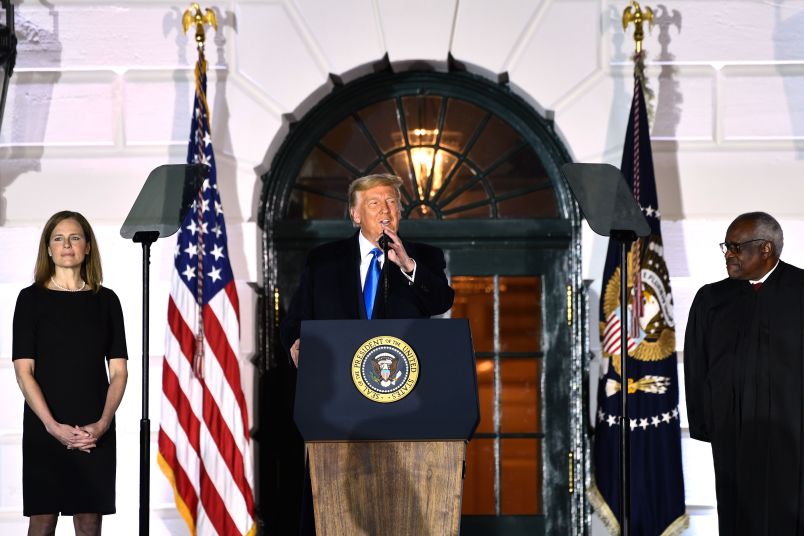Donald Trump asked the Supreme Court on Wednesday to reject a request from federal prosecutors to fast-track the former President’s claim that Special Prosecutor Jack Smith’s team cannot charge him for acts he took while in office.
Trump has been trying to delay the criminal cases brought against him, and accused Smith in a filing of asking the court to move at “breakneck speed.” Smith had asked the Supreme Court to scoop up consideration of the immunity issue from the D.C. Circuit, taking over the case earlier in the appeal cycle than is normal.
In a 44-page filing, Trump said that the court would expose itself to errors if it leapfrogged the D.C. Circuit, and accused Smith of having no interest in speeding the case up apart from a “partisan” one.
Trump has sought to delay both the D.C. Jan. 6 case and the Florida Mar-a-Lago documents case until after the November 2024 election, when, if elected, he could make them go away. In D.C., his motion to dismiss on grounds of presidential immunity presented a real, unexplored question of how that immunity interacts with criminal law, setting up the potential for months of delay. The district court judge denied Trump’s motion to dismiss, leading the former President to appeal to the D.C. Circuit and Smith to ask for the high court to speed up review.
Trump argued to the Supreme Court that because Smith won the motion at the district court level and was therefore not the appellant, he then lacked standing to ask the Supreme Court to get involved. He also reiterated, albeit in staid legal language, familiar claims that he, in fact, is a victim in all of this; that the case was brought not out of the public interest, but for political motives. Speeding up consideration would therefore only serve a “partisan motivation,” he argued.
The real motive in keeping the case fast-tracked, Trump suggested, is to ensnare him at “the height of a presidential campaign.”
Trump emphasized throughout that the immunity question involves unexplored issues which deserve consideration and thought from the entire judicial system — not only the Supreme Court. He’s trying to thread a difficult needle after Smith imposed a bind on him by asking the Supreme Court to fast-track the case.
On the one hand, if Trump loses at the D.C. Circuit he’ll likely want the Supreme Court to weigh in later. But because he needs the case to be maximally delayed, he can’t oppose the court hearing the case and then ask it to take it up later.
So, the result is an argument where Trump says only that speeding up the case would create the “hazard” of errors, or that fast-tracking it plays into the “partisan interest” of “[Smith]’s superior,” President Biden.
It also leads to the extremely odd suggestion from Trump’s attorneys that the Supreme Court might issue an incorrect decision in the case out of “haste.” “If and when it considers these issues, the Court should grant briefing on the ordinary schedule,” Trump lawyers wrote in the conclusion, saying that deciding the case “correctly” and not “quickly” is “imperative.”
Trump, of course, may be hours or days away from asking the Supreme Court to decide as soon as possible another case of unprecedented constitutional importance that his behavior has provoked: whether the Colorado Supreme Court ruled correctly in finding that the Constitution’s ban on insurrectionists holding office disqualifies him from appearing on that state’s GOP ballot.
There are two elements to Trump’s immunity claim. One is an extremely broad view of what constitutes an official act; Trump argues that his efforts to undo his loss in the 2020 election fall under that umbrella. The second question is the role of impeachment: does acquittal by the U.S. Senate mean that double jeopardy bars criminal prosecution over the same conduct?
Trump wants the failure of Republican senators to convict him in February 2021 to be the end point of his liability for Jan. 6, contrasting the “formidable structural checks” of impeachment to “the action of a single enterprising prosecutor and a compliant grand jury.”
Trump brandishes Congress’s failure to impeach him to suggest that Smith is acting on partisan motives, using that claim as well as a convenient Wall Street Journal editorial to try to ward the court off taking the case early. The Dec. 15 editorial, titled “Jack Smith and the Supreme Court,” accused the special counsel of trying to “drag the justices into his political timetable.”
It’s too easy a layup for Trump’s attorneys to ignore. Echoing that language, the former president characterized Smith as “seek[ing] to embroil this court in a partisan rush to judgment on some of the most historic and sensitive questions that the Court may ever decide.”
“The Court should decline that invitation,” Trump attorneys said.
The Supreme Court is virtually guaranteed to confront this issue at some point. The question is whether it lets the D.C. Circuit take the case, hold oral arguments, and issue a ruling before one of the two sides almost inevitably appeal.
Smith is trying hard to keep the case to its current March trial date, more than six months before the November election. It’s up to the court whether it will take him up on the offer for a sped up schedule which could preserve that date or leave minimal delays.







I can’t wait for the day we don’t have to hear about Trump anymore. When will this be?
I do believe this is the very first example of Trump and/or his minions asking to pump the brakes in order to “get it right”.
Don’t get your hopes up. Unless he drops dead, he’ll be front page news all the way through 2024 even after he loses the election, and probably a bit into 2025 as well. This timeline sucks.
You’re gonna love holiday meals with the family this year.